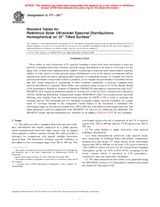We need your consent to use the individual data so that you can see information about your interests, among other things. Click "OK" to give your consent.
ASTM G177-03
Standard Tables for Reference Solar Ultraviolet Spectral Distributions: Hemispherical on 37 Tilted Surface
STANDARD published on 10.9.2003
The information about the standard:
Designation standards: ASTM G177-03
Note: WITHDRAWN
Publication date standards: 10.9.2003
SKU: NS-57537
The number of pages: 9
Approximate weight : 27 g (0.06 lbs)
Country: American technical standard
Category: Technical standards ASTM
Annotation of standard text ASTM G177-03 :
Keywords:
global hemispherical, materials exposure, terrestrial, ultraviolet solar spectral irradiance, ICS Number Code 17.180.20 (Colours and measurement of light)
Additional information
| 1. Scope | ||||||
|
1.1 The table provides a standard ultraviolet spectral irradiance distribution that maybe employed as a guide against which manufactured ultraviolet light sources may be judged when applied to indoor exposure testing. The table provides a reference for comparison with natural sunlight ultraviolet spectral data. The ultraviolet reference spectral irradiance is providded for the wavelength range from 280 to 400 nm. The wavelength region selected is comprised of the UV-A spectral region from 320 to 400 nm and the UV-B region from 280 to 320 nm. 1.2 The table defines a single ultraviolet solar spectral irradiance distribution: 1.2.1 Total hemispherical ultraviolet solar spectral irradiance (consisting of combined direct and diffuse components) incident on a sun-facing, 37 tilted surface in the wavelength region from 280 to 400 nm for air mass 1.05, at an elevation of 2 km (2000 m) above sea level for the United States Standard Atmosphere profile for 1976 (USSA 1976), excepting for the ozone content which is specified as 0.30 atmosphere-centimeters (atm-cm) equivalent thichkness. 1.3 The data contained in these tables were generated using the SMARTS2 Version 2.9.2 atmospheric transmission model developed by Gueymard (1,2). 1.4 The climatic, atmospheric and geometric parameters selected reflect the conditions to provide a realistic maximum ultraviolet exposure under representative clear sky conditions. 1.5 The availability of the SMARTS2 model (as an adjunct to this standard) used to generate the standard spectra allows users to evaluate spectral differences relative to the spectra specified here. |
||||||
| 2. Referenced Documents | ||||||
|
We recommend:
Technical standards updating
Do you want to make sure you use only the valid technical standards?
We can offer you a solution which will provide you a monthly overview concerning the updating of standards which you use.
Would you like to know more? Look at this page.




 Cookies
Cookies
